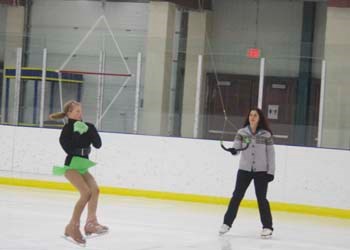The new figure skating harness that Skate Thompson recently had installed in the C.A. Nesbitt Arena is simply described by one of the coaches.
"It rocks," says Sharon Maki. "There's really not much to it. It's very simple. It's basically a pulley system with a pendulum so it's not complex but it's such an awesome tool so we're very lucky."
The harness replaces the previous harness that the club had, which went missing when renovations were done to C.A. Nesbitt Arena and hadn't been used for several skating seasons prior to that.
Megan Wischnewski, one of the skaters who's been using the new equipment, admits that it's enjoyable being able to jump with assistance, even if that's not the purpose behind it.
"It's fun but it's not supposed to fun," she says. "It's a learning tool. It helps with the jumps and you can get more height."
The harness was designed and manufactured by Mark LeBel, a former competitive amateur figure skater and performer in ice capades and similar performances, who operates in Buffalo, New York. According to his website, his harness is the only one endorsed by the Professional Skaters Associations and improves on previous skating designs by incorporating a spacer bar which allows skaters to keep their body upright when entering a jump. Other designs require skaters to lean forward to avoid getting entangled with the guide rope.
Buying the harness and paying for LeBel to travel to Thompson and install it wasn't cheap, says Val Wischnewski, Skate Thompson's test chair, at more than $3,000 for the harness itself and about the same for the costs associated with the installation. But Maki says it's worth the investment.
"What it does is it helps the kids get a feeling for the jump," she says. "So, when they start doing single jumps, it's just one rotation, they go up, they rotate it's not so hard. Once they start going into double and triple jumps, they need to get an idea of holding their position in the air so they get the extra rotation. It's a very odd feeling. This gives us a chance for them to practise without being, basically, scared, of falling on the ice."
Megan Wischnewski, now in her third season of figure skating, says using the harness helped her nail the mechanics of double rotation jumps and gave her the confidence that helps her perform double jumps out of the harness now.
"I just started this year doing doubles," she said and without the harness she's not sure if she'd be at that stage yet. "I might have but it'd take longer."
"We learned to do double jumps and a rotation-and-a-half just by using the harness," says Maki. "So we got an accelerated version because it would have taken probably a year for her to get it otherwise."
The purpose of the harness is not to help skaters with their jumping, says Maki. In fact, the coach at the other end of the pulley rope doesn't get involved until the skater is already in the air.
"They still have to jump," says Maki. "I'm not going to go and pull them in the air. My job is to help slow down their coming down portion. They're going to make themselves jump higher but I can hold them in the air longer."
With worries about the landing relieved, skaters are then free to concentrate on their body position in the air, which is the key to successful spinning jumps.
"[Megan] will come down but doesn't understand how to stop her body from rotating," Maki explains. "Now we've done two rotations in the air, she needs to understand how to stop the rotation. Typically, once they understand the rotation, it's all about the landing."
The harness isn't just good for the skaters, however. It also reflects on the nature of Skate Thompson, which now has a tool that is used by all of Canada's national training centres for figure skaters.
"We think it's very important to have a real skating club," Maki says. "Just because they live in Thompson doesn't mean that they can't get the same training that they could in Winnipeg. That's very important. This is one of those tools, so were very fortunate."
The harness is capable of supporting skaters who weigh up to 200 pounds, but Maki says that, in reality, people that size would not likely be using it anyhow.
"If you are pushing 200 pounds, you're probably not doing the jumps anyways," she says. "It's the men that get close to 200 pounds and usually when they get really tall and muscular like that, the jumps stop happening. They stop happening around the triple zone because you don't have the same inner body centre of gravity. It starts to change so that's really all they can do and really and truly, it's a whole different kettle of beans when they're that weight."
Many of Skate Thompson's skaters who use the harness are 70 pounds or less, so the pulley enables coaches to slow their skater's descent without exerting a lot of energy, often with just one hand on their end of the rope.
"Some of the kids, they'll go travel to summer skating schools, but either their coaches they have there don't put them in it or it's not at that rink," says Maki. "They love it."
But even though the harness makes learning jumps easier - and less likely to result in bruising - skater have to put in plenty of work before they're ready for it.
"You have to train the skills," Maki says. "You have to train rotation. Rotation for skating comes from the hips. It's all hips so they need to understand that before you get in there because otherwise it's not going to make a difference. They need to have all the tools to get the jump going - so takeoff position, their in-the-air position, how they rotate and how they land before they can go in."




